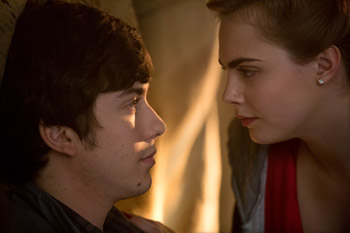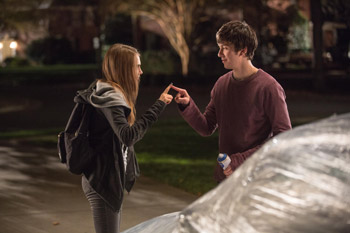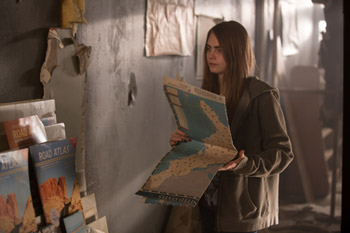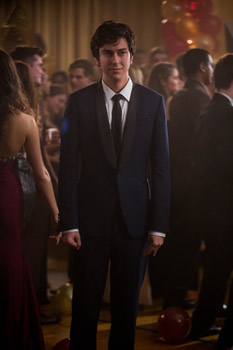Cara Delevingne Paper Towns

Cara Delevingne Paper Towns
Cast: Cara Delevingne, Nat Wolff, Cara Buono
Director: Jake Schreier
Genre: Mystery, Romance
Rated: M
Running Time: 109 minutes
Synopsis: Adapted from the bestselling novel by author John Green ('The Fault in Our Stars"), Paper Towns is a coming-of-age story centering on Quentin and his enigmatic neighbor Margo, who loved mysteries so much she became one. After taking him on an all-night adventure through their hometown, Margo suddenly disappears-leaving behind cryptic clues for Quentin to decipher. The search leads Quentin and his quick-witted friends on an exhilarating adventure that is equal parts hilarious and moving. Ultimately, to track down Margo, Quentin must find a deeper understanding of true friendship-and true love.
Quentin Jacobson, or 'Q," is intelligent, a loyal friend and a romantic. He's seventeen years old and in his senior year of high school. Q believes that everyone gets a miracle in life and his came when he was nine, the day Margo Roth Spiegelman moved in next door.
Margo was always an adventurer; Q, not so much. Over the years Q has become best friends with Ben and Radar. Margo, on the other hand, has become increasingly daring and mysterious, and is now one of the ultra-cool kids in high school. So, Q and Margo drifted apart.
One night, only a few weeks before prom, Margo shows up at Q's window and leads him on an all-night covert adventure that Q is certain signals a` return to his friendship – and maybe more? – with the unrequited love of his life and true soul mate. He knows his life is about to change. And it does.
The next morning, Margo is gone. She has simply disappeared and hasn't left word with anyone. Or has she? Q starts to find clues seemingly left just for him - signs of where she went and why she left. By solving those clues, another adventure begins. Q, with his friends Ben and Radar and with their new friends Lacey and Angela, embark upon a journey to track down Margo. In unraveling the mystery, Q discovers the true meaning of friendship and the complexities of the enigma that is Margo.
Paper Towns
Release Date: July 16th, 2015
About The Production
A -Paper Town' John Green's third novel Paper Towns was released by Dutton Books. It was an immediate hit, debuting at number five on The New York Times bestsellers list for young adult fiction.
The book drew fans around the globe, especially in the U.S., Europe, South America and parts of Asia.
Readers related to its characters and were intrigued by its title. The term 'paper town" was created when cartographers Earnest G. Alpers and Otto Lindberg of the General Drafting Company invented the town of Agloe, New York by placing the fictitious town on a map at the intersection of two dirt roads in the southern Catskills.
They did so to protect copyright. If their made-up town ever showed up on another map, they could make a case that their work was plagiarized.
But the story's biggest draws were its characters and their friendships. 'It's the story of Quentin and his friends searching for Margo, but in that process, it culminates in an epic road trip," says John Green. 'It's really about finding a deeper meaning of friendship and learning to imagine other people as being more complex than initial impressions."
 Those themes resonate with young people, John Green continues. 'Every teenager knows what it's like to be put in a category, to be seen as one thing when you are, in fact, many things. So I think that's the first thing people will connect with. I also think audiences will connect to the love stories in the movie. And then, the most important thing, to me, is that it's a very funny movie about real friendship, and how real friendship can sustain you. Romantic love is not the only kind of valuable love."
Those themes resonate with young people, John Green continues. 'Every teenager knows what it's like to be put in a category, to be seen as one thing when you are, in fact, many things. So I think that's the first thing people will connect with. I also think audiences will connect to the love stories in the movie. And then, the most important thing, to me, is that it's a very funny movie about real friendship, and how real friendship can sustain you. Romantic love is not the only kind of valuable love." Populating -Paper Towns' – The Cast And Filmmakers
For producer Wyck Godfrey, a producer on The Fault in Our Stars, the decision to jump back into another John Green adaptation was irresistible. 'My partner Marty Bowen and I had read Paper Towns even before we read The Fault in Our Stars," he says. 'So when we were making The Fault in Our Stars we began talks with John Green about another project. We asked him about Paper Towns. The thing I love about the story is that it's a mystery, an adventure, and a comedy, and it felt very cinematic."
John Green says his experience on the set of The Fault in Our Stars was a key factor in turning over this story to that same team of producers. 'I had extraordinary producers in Wyck Godfrey and Isaac Klausner and Marty Bowen, who again welcomed me to the set every day and made me a part of both movies, even though none of that was contractual," says the author. 'It was a dream experience. Paper Towns is an opportunity to take a very different story [from The Fault in Our Stars], but use the same filmmaking model and sharing it with people."
To write the screenplay, Godfrey turned to screenwriters Scott Neustadter and Michael H. Weber, who had adapted The Fault in Our Stars. Scott Neustatdter says they were happy to rejoin Team John Green. 'It's cool to have the band back together, and it's been a really rewarding experience for us to be invited back."
Michael Weber was equally enthusiastic, noting that 'John Green is a tremendous writer, which makes our jobs a lot easier. His books are so well plotted, the ideas and the characters are so strong, and the dialogue just flies off the page. Unfortunately, we can't keep everything in the book, so deciding what stays and what goes is the hardest part of the process."
Scott Neustadter adds: 'We approach John Green's books as fans, first. We consider how best to encapsulate the voice of the book as cinematically as we can. One of the few challenges in adapting John Green's books is figuring out the best way to voice the characters' inner thoughts, either through dialogue, action or character interactions."
The other key alumnus from The Fault in Our Stars is Nat Wolff, who played Isaac in the 2014 blockbuster. It was on the set of Fault that executive producer Isaac Klausner approached Nat Wolff about taking the lead in Paper Towns. 'When we were on set, Isaac said to me, with a mischievous look in his eyes, that I should read Paper Towns," the young actor recalls. 'It became my favorite of John Green's books, and I immediately responded to the character of Q. About six months later Wyck Godfrey offered me the role. Even before he finished his sentence, I said yes."
Nat Wolff says he was drawn to the story's coming-of-age elements. 'Q is a character who plays it safe, and is smart and focused," he explains. 'He makes a lot of plans. But beyond his friendship with [best pals] Radar and Ben, he avoids the rest of the world. But through his relationship with Margo and the road trip to find her, he learns to take chances and open up."
Nat Wolff's second appearance in a film based on a John Green novel was welcome news to the author. 'Nat is a rare, rare person," says John Green. 'He's uncommonly talented as an actor, but also uncommonly kind and generous as a person."
Nat Wolff's casting at such an early stage was also a bonus for Scott Neustadter and Michael Weber. 'Paper Towns is the first time we knew who our lead actor was going to be before we began writing the screenplay," Michael Weber explains. 'It made our job easier because we knew Nat Wolff could handle anything we threw at him, and make it even better."
Isaac Klausner sees parallels between Jake Schreier's film and John Green's stories. 'Like John Green's books, Robot and Frank has an open heart and is generous with its audiences," he explains. 'Jake Schreier was the first director to whom we sent the novel and script. His excitement about Paper Towns blew us away. On his own, Jake Schreier traveled to Orlando on location scout, and he tracked down all of the locations that inspired John Green in writing the novel. Jake Schreier also took stunning photographs and really helped us envision not just the film we were already hoping to see, but so much more.
'Jake Schreier put together an incredible presentation of his vision for the movie," adds Wyck Godfrey. 'He understood Q and his journey. Jake Schreier gets that feeling of trying to get through high school and move on to the rest of your life, but there's always that last-minute thing that knocks you on your ass."
Jake Schreier counts himself among the book's legion of fans. 'It's a captivating mystery, among many other things," he says. 'In addition, I connected with its depiction of high school students and their experiences. It has such an interesting message about how we project images onto other people, and how difficult it is to live up to those images.
 'I also loved the visual potential of the story," Jake Schreier continues. 'The mystery adds a propulsive element, which helped me connect the visuals and really drive the characters to the story."
'I also loved the visual potential of the story," Jake Schreier continues. 'The mystery adds a propulsive element, which helped me connect the visuals and really drive the characters to the story." Working with John Green was another highlight for the director. 'The first thing that struck me about John Green and having him aboard as an executive producer was that he just wanted to make a great movie by tapping into the soul of his book . He was really excited to be involved."
Nat Wolff, who has become close friends with John Green, elaborates on the author's presence on the set. 'It's funny because John Green jokes that on location he just walks around and eats craft service. But in reality he sets the tone for the set because he has such a great sense of humor and is such a cheerleader for the actors. John Green is so passionate about the process of turning his books into films. It's easy to imagine a novelist on set, and it being the worst experience in the world for him or her, -They're ruining my book!' or something like that. But John Green is always there right with us. He trusts us."
With Wolff and Jake Schreier aboard, the next order of business was to cast the pivotal role of Margo Roth Spiegelman. John Green talks about creating the character from real-life experience. 'I knew a boy who was like Margo growing up," he recalls. 'He once won a $100 bet by hopping on a freight train and traveling from Alabama to Tennessee. Then he had to pay well more than $100 to take the bus back. He was that kind of guy who would lose money to win a bet."
Margo is Q's polar opposite. 'Q thinks he's got it figured out," says Jake Schreier. 'He's got his studies, his friends, and he's got a plan to go to college and then medical school. Margo has no plan whatsoever, beyond the next week or two. And when they reconnect one night, she inspires him to take more risks. She forces him out of his comfort zone."
As John Green explains, Q's perception of Margo is a key element in the story. 'There's always a disconnect between the way we imagine something and the way that we actually experience it," he notes. 'I think the way Q looks at Margo is very different from Margo's true nature. Margo's last name is Spiegelman, and Spiegelman means -mirror maker' in German. What people see in Margo is a reflection of them and really doesn't say much about her. To Margo, that's infuriating. It's really difficult to live like that.
'Here's a young woman who's been mis-imagined her entire life," John Green continues. 'There's always that girl in high school who is so beautiful and so cool, she seems to be walking in slow motion. Margo Roth Spiegelman has spent her entire life being that girl publicly and, as all of those women do, I think, resenting that failure to understand her complexity. And who knows that better than Cara Delevingne? Who has a better idea of what it's like to be the person behind the mirror, than this wonderfully-talented young actress who is also a wildly-famous supermodel?"
The process that led to casting Cara Delevinge wasn't an easy one. 'We knew that Margo had to be the unattainable perfect high school girl," Wyck Godfrey says. 'She's the one that every guy pines over but can't get. We also knew the role required an actress with super-expressiveness and a wild nature she could access while also possessing emotional vulnerability and a broken quality."
'It was an immensely tricky casting decision," Jake Schreier confirms. 'We had to honor Margo's energy and find the girl who, when she comes to your window at midnight, you'd jump out of it for her, and then when she disappears, you'd drive 1200 miles to find her."
'So we were lucky to find Cara Delevingne," Wyck Godfrey continues. 'She has incredible warmth, kindness, and a sense of fun that really comes across onscreen. What touched me the most about Cara Delevingne was her ability to access how Margo has created this persona that she feels she has to live up to. That's not the true Margo, so she decides that her only path to self-discovery is to leave town. Cara Delevingne really tapped into that."
To play an American high school student, the young Brit all but lost any trace of her accent and spoke American English through most of the production, both on and off camera. She had seen the film adaptation of The Fault in Our Stars and read Paper Towns and felt this was a project she had to be a part of. 'I started reading the novel and noted the similarities between Margo and me," Cara Delevingne says. 'I remember when I went to my first audition for the part of Margo, I said -I used to be like her.' I think that's probably part of the reason I got the role – because I was able to explore the part in myself."
The heart of Paper Towns rests in its depictions of friendship and its accompanying adventures, mysteries and even the aggravations that pull young people together at a significant point in their lives. Q, Ben and Radar are the best of friends. Their circle of friendship grows with Margo's disappearance. As John Green explains, 'Q, Ben and Radar are extremely tight but as their high school years come to a close, they grapple with the fact that their friendship is soon going to be different."
'There's a real connection between these friends, and so the humor between them feels lived in and real," adds Jake Schreier.
'Ben is this nerdy kid who desperately wants to have a girlfriend but has no idea how to go about getting one," says Austin Abrams, who takes on the role. 'Like the other characters, he undergoes big changes in his thinking about girls, and realises that a girl he's long had a crush on, Lacey, is not only pretty, she's actually very cool and sweet."
For the part of Radar, the filmmaker cast newcomer Justice Smith. 'Radar is a really sweet kid who plays saxophone in the high school band," says Justice Smith. 'He's a little afraid of bringing his girlfriend Angela to his home because his parents own the world's largest collection of black Santas. He's very embarrassed that his house has, you know, like, 4,200 black Santas in it."
John Green uses that story element as a mirror to Q's initial, superficial view of Margo. 'It's ludicrous how monolithically we imagine Santa," he points out. 'And there's a moment in the story when Angela, upon learning of this unique collection, says, -I think it's really cool that your parents are helping to make Santa more complex.'"
Rounding out the cast are Halston Sage as Lacey, and Jaz Sinclair as Angela. John Green explains the characters' special strengths. 'Lacey Pemberton is blonde and bubbly and people make all of these assumptions about her. In fact Lacey is quite complex and the young woman who plays her, Halston Sage, is very much like that. You meet Halston and you think, 'Oh I know a lot about blonde girls from California.' Then as you get to know her she slowly takes apart each of those assumptions.
'And the character Angela is really the most grounded in the movie," John Green continues. 'She doesn't have it all figured out, either, but at critical moments she takes control."
Overcoming preconceived notions about people in our lives was a theme that drew Halston Sage to the project. 'I fell in love with story's portrayal of Lacey as someone who wants to be seen for her true qualities," says Halston Sage. 'She's very intelligent and isn't all that concerned about being popular. Lacey begins to come out of her shell when she befriends Q, Ben and Radar, whom she really didn't know well for most of their high school years. It makes her really relatable and you know she has heart."
Joining Lacey and the boys on the road trip is Angela, played by Jaz Sinclair. The actress says the role is a perfect fit, explaining that Angela 'doesn't really fit into any stereotype. Radar acts like he's scared of her through the first half of the movie and you think that Angela must be a little unpleasant. But as the story progress, she's revealed to be a super-cool girlfriend who genuinely loves Radar and who is eager to go on whatever adventures lie ahead."
 Unbeknownst to the filmmakers, Jaz Sinclair and Justice Smith had previously worked together and knew each other quite well. 'So we got a bonus chemistry in that dynamic," says Jake Schreier.
Unbeknownst to the filmmakers, Jaz Sinclair and Justice Smith had previously worked together and knew each other quite well. 'So we got a bonus chemistry in that dynamic," says Jake Schreier. All the characters share this critical factor of being relatable, thanks to John Green's unique voice and ability to create young protagonists that are real, caring, and multidimensional. Nat Wolff says, 'Paper Towns is funny, romantic and, yes, real. It reminds me so much of my friends in high school and so much of girls I've been in love with and it's all so close, it's scary."
John Green credits the realism of the characters to the actors' connection with their characters, and with each other. These six young people have truly become great friends. I think they'll be friends for the rest of their lives. They became the tight knit group I'd always hoped they'd be, and I just adore them. They make me feel very old, but they also fill me with joy."
Because the story is at its core, a road trip, production needed to be able to film all the characters in a van traveling from Orlando, Florida to Agloe, New York. To accomplish this they set up production in Charlotte, North Carolina, where the diverse geography could provide the look for the entire journey, via van, in a single location. Visual effects plates and interactive lighting provided additional backgrounds.
Jake Schreier and the cast endured some challenging conditions during production. 'Shooting in a van is not the easiest and most fun thing to do," he says. To enhance the dynamic between the young actors, Jake Schreier just turned actors loose. 'There was a lot of improv going on and we had fun just letting them go."
The camera was often an active participant in the scenes, which, says Jake Schreier, really helped 'locate Q's perspective and enhance the mystery."
For Jake Schreier, the characters' journey mirrored many of his own high school experiences. 'Paper Towns is about a particular moment I can remember really well from the end of my high school years," he explains. 'I think it's a -big deal' moment for everyone, because it's the last time you'll see most of your friends, and you become individuals apart from one another. It begins as a romance and along the way becomes something very different. The story becomes more about friendship and the way we relate to and perceive one another."
Paper Towns
Release Date: July 16th, 2015
MORE





